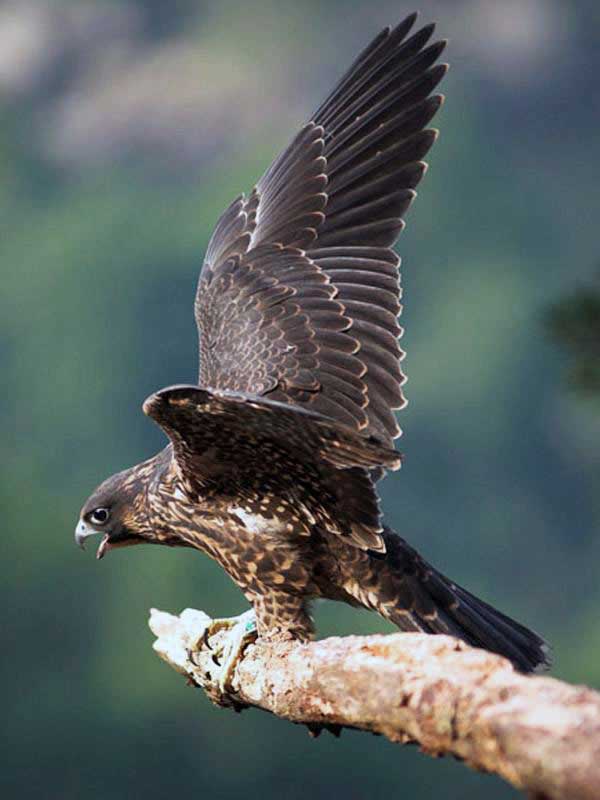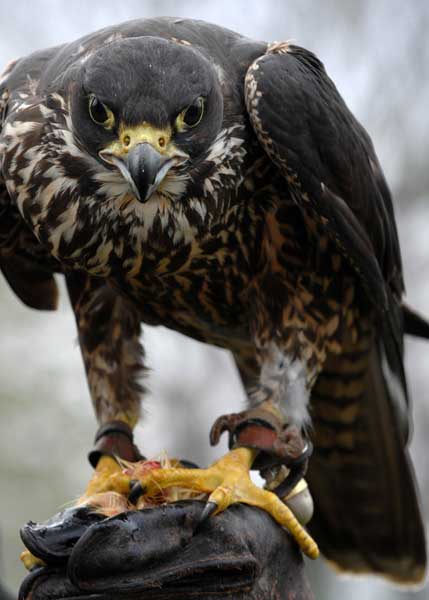“Wings Over Colorado” uses Free-Flying Raptors, Laser & RC Technology, Dogs and Trapping for its Bird Abatement processes.
The risks that birds create in certain circumstances have brought the need for Bird Abatement. Amongst those risks are loss of investments in farming and aviculture, aircraft crashes, and bacteriological and viral contamination. With more recent outbreaks of Newcastle disease and the Avian Flu, it is reasonable to expect that bird abatement will become a larger industry.
 Problems Include:
Problems Include:When a flock of birds descends upon a farmer’s field, they can eat up the seed and produce, damaging a farmer’s crop. Canadian Geese, once a fully protected species of migratory bird, have become so comfortable at some farms as to abandon their migrations and take up residency. Crows, starlings, bluejays and many other species also pose a threat to crops.
Raptors and other predators are an age-old concern for those who raise gamebirds and pigeons as livestock.
Birds tend to see the open grasslands of an airport as an oasis. They quickly become desensitized to the planes, and set up residency, however birds flying near an airport have been responsible for many aircraft accidents resulting in loss of life and property. Whether by merely distracting the pilot, breaking a windscreen, striking the propeller, or causing a jet to crash when a bird is sucked into the aircraft’s turbines, airborne birds are a hazard at an airport.
Concentrations of seagulls frequenting landfills in search of discarded food in coastal areas have been shown to cause significant health hazard by dropping feces in nearby waters.
 Solutions
SolutionsOne of the earliest methods of bird abatement is the scarecrow that farmers used to erect in their fields to keep the birds from eating planted seeds and crops. Fashioned of a stick frame covered in human clothing stuffed with straw, and often garnished with tin cans on strings and pie tins, the image of a scarecrow in a farmer’s field has become classic.
Unfortunately, it proves ineffective, as the birds quickly become comfortable with the statue. In more recent times, netting has been placed over berry crops, poisons have been put out in the fields, and falconers’ services employed, all of which are far more successful. The proverbial scarecrow, which often ended up serving as a perch for the birds they were expected to frighten away, are now largely a romantic relic of agriculture.
In some places, poison has been set out to kill off the offending birds. This environmentally unsound practice still occurs, but is on the decline because other creatures also consume the poisons. Secondary kills of desirable predators, as well as roaming dogs, cats, have demonstrated the dangers. Poisons are not discriminating. There is also concern that a child may inadvertently eat the poison bait. In recent times, more evolved and ecologically friendly methods have been used.
One of the more common and popular modern methods of Bird Abatement is employing falconers to fly trained raptors over the fields, landfills and airports. When the raptor appears and chases the offending birds, the prey quickly scatters. Without regular flights several times a day, they will return, but so long as the raptor’s presence is maintained, the problem is largely solved. Falconers’ services are employed all across the country, with considerable success. Thus falconry, which has long been an antiquated pastime since its medieval origins, has resurfaced as a profession.
“Wings Over Colorado” is committed to providing traditional Falconry techniques to control nuisance birds in vineyards, crop fields, airports, and landfills.
Falconry Bird Abatement is the use of trained Falcons to frighten and scare off nuisance birds which cause loss of revenue for crop growers, health hazards, and safety concerns at airfields.
Very often the presence of the Falcon is enough to discourage and intimidate the prey species. It’s a natural predator and prey association that evolution has programmed them to avoid.
Historically, everything from netting, scarecrows, loud horns, cannons, flares, shotguns and poisons have been used, but birds will find ways to adapt to these second-rate methods. Falconry Bird Abatement is quiet, discrete, eco-friendly and very sustainable. The objective is not killing the nuisance birds, but scaring them off the grounds.
Falconry is sustainable. It is a natural technique that is part of nature and it is chemical-free, eco-friendly, and non-polluting.
Falconry works because nuisance birds are naturally encoded to be frightened of Raptors/Falcons. They are their natural-born enemies. Pesky birds never get acclimated to Raptors, however they do adapt to noise makers like loud horns, propane cannons, flares, and even shotguns.
Use Our Bird Abatement Inquiry Form
Wings Over Colorado LLC
Phone: (720) 425-8968
Email @ rob@wingsovercolorado.com
Copyright © 2012 Wings Over Colorado. All Rights Reserved. Top ↑